2017 Honda Cbr1000rr Sp Price

– New 2017 CBR1000RR SP Review of Changes: Engine / Horsepower Increases, Frame & Suspension Details + More! –
It's finally official, Honda has let the cat out of the bag at the 2016 Intermot Motorcycle Show and released (2) new versions of the 2017 CBR1000RR Superbike! This page will go over the 2017 CBR1000RR SP whereas I'll have a separate page that will go over all of the Specs & Changes to the 2017 CBR1000RR SP-2.
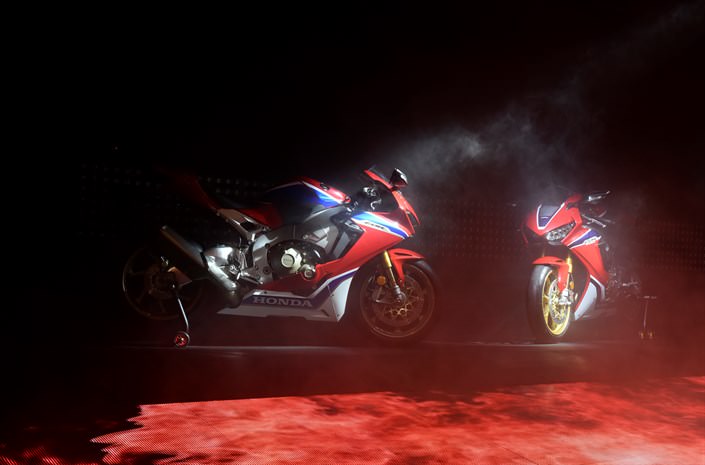
2017 CBR1000RR SP Model updates: The Honda CBR1000RR Fireblade SP goes to the next stage of Total Control. Power to weight ratio is improved by 14% – reaching the best level ever for the Fireblade – thanks to a 33lb (15kg) weight reduction and 11 horsepower (8kW) power boost. It's also equipped with semi-active Öhlins Electronic Control suspension, plus Honda Selectable Torque Control, Selectable Engine Brake, new ABS, Quickshifter, Downshift Assist, Riding Mode Select System and Power Selector. RC213V-S MotoGP derived technology elevates the riding experience even further.
I know there's a few key points and specs many of you guys will be looking for right off the bat so I'll touch on them real quick…
Quick 17′ CBR1000RR SP / SP2 Spec Overview:
- 2017 CBR1000RR SP Horsepower: 189 HP @ 13,000 RPM
- 2017 CBR1000RR SP Torque: 85.6 LB/FT TQ @ 11,000 RPM
- 2017 CBR1000RR SP Price / MSRP: $19,999 (base model $16,499)
- 2017 CBR1000RR SP2 Price / MSRP: $24,999
- 2017 CBR1000RR SP Release Date: March 2017
- 2017 CBR1000RR SP2 Release Date: May 2017
2017 CBR1000RR SP VS CBR1000RR SP2 | What's the Difference?
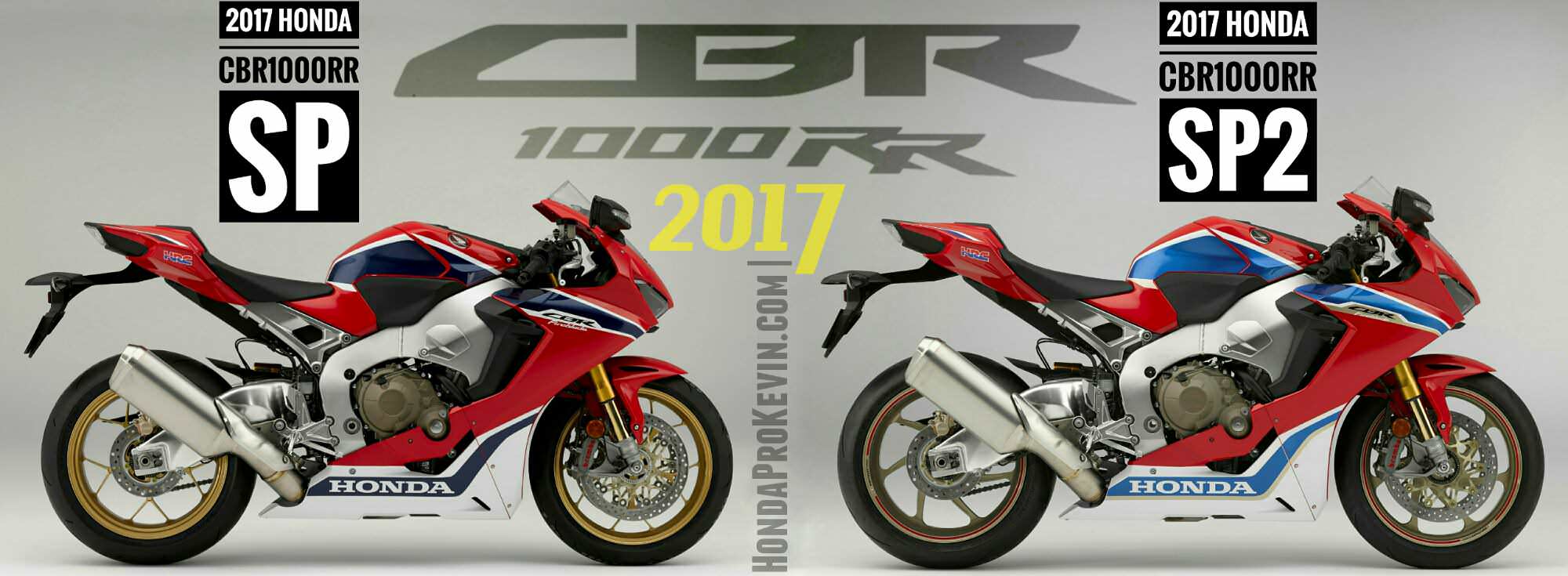
There's some confusion as to the 2017 CBR1000RR SP VS CBR1000RR SP2 SO what the differences between the (2) 17′ CBR1000RR SP models are so let's dive into that before we get any deeper into the specs of the 'regular' SP model.
CBR1000RR SP2 Model Updates / Differences: The CBR1000RR Fireblade SP2 is a road legal homologation special using the Fireblade SP as a base, ready for race use.
- Marchesini wheels
- Revised cylinder head: valves, combustion chambers and pistons
- Racing kit to be available
Visually the carbon pattern insets and gold striping interwoven into the Tri-Color paint mark the Fireblade SP2's difference over the 'stock' machine and gold Marchesini wheels (reducing front/rear wheel inertia by 18/9%) are another clue. But the real differences – and what gives the CBR1000RR SP2 ultimate racing potential – lie inside the engine and, in turn, the parts that can be added from the two race kits that will be available.
While the 76mm bore is identical to the SP, the Fireblade SP2 cylinder head runs 1mm larger 31.5mm diameter intake valves and 1.5mm larger 25.5mm diameter exhaust valves, with 10°/12° included valve intake/exhaust included valve angles (from 11°/11°). The valve pitches are identical, maintaining cylinder head width.
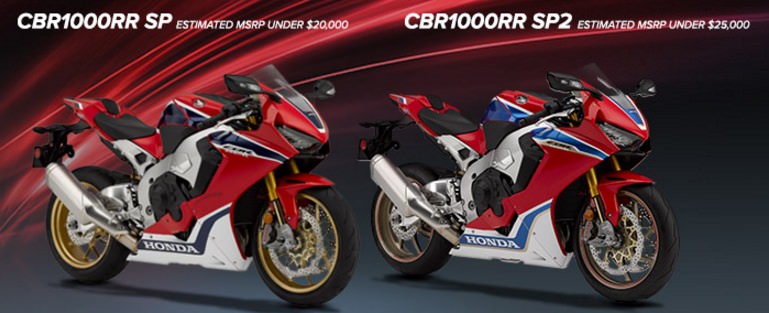
It runs the same 13.0:1 compression ratio but uses valve shapes and combustion chambers optimised for efficiency. Elongated spark plugs and a water jacket tightly wrapped around the combustion chambers improve cooling; this technology is derived directly from Honda's RC213V MotoGP machine.
The pistons use an exclusive crown design with heat treatment that strengthens the area around the piston boss, which itself employs a 2.5mm shorter (and 8g lighter per cylinder) piston pin. Ready to house high-lift camshafts the outer diameter of the valve lifter has grown 2mm to 28mm, while total height and thickness have been reduced saving weight.
The CBR1000RR SP2's electronic control devices are the same as those of the SP, with exclusive SP2 settings. For both race and general circuit use, a racing kit will be available.
- Contents:
- 1. Introduction
- 2. Model overview
- 3. Key features
- 3.1 Chassis/electronics
- 3.2 Chassis
- 3.3 Engine/electronics
- 3.4 Engine
- 4. Quick overview of features & specs
- 5. Technical specifications
1. 2017 CBR1000RR SP Introduction
1992. And something new stunned the motorcycling world. Radical thinking from Honda focused on the ratio between power and weight and the CBR900RR Fireblade arrived fully formed at the perfect balance point between the two.
Physically smaller and much more agile than the larger capacity competition, its four-cylinder engine also packed real punch. The Fireblade reset expectations of just what an open-class sports bike should be, and what it could do in an era when outright horsepower and straight-line speed had long held center stage.
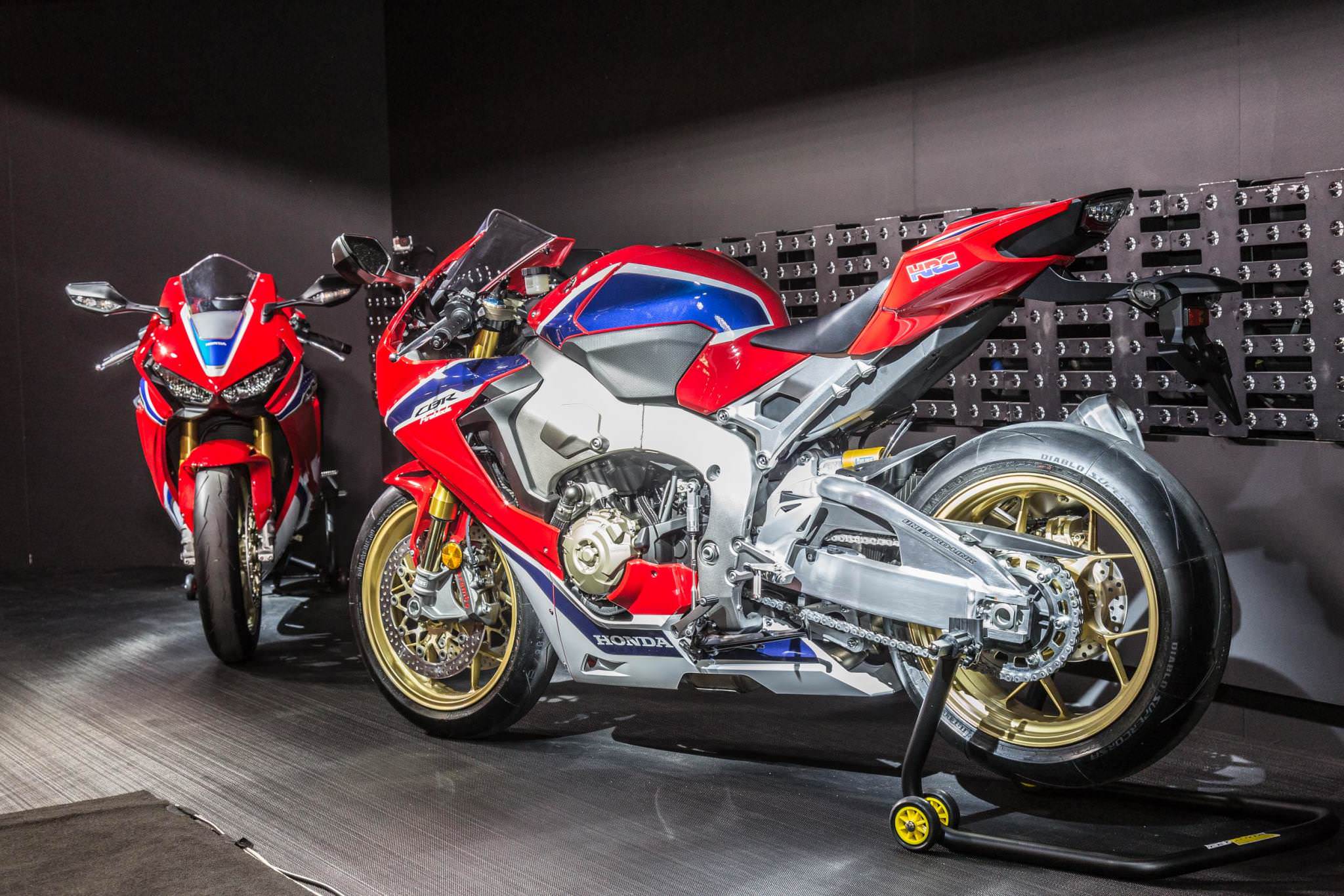
Over the following 25 years the Fireblade has seen many changes and been through many evolutions – each underpinned by the concept of Total Control. Each generation has built on the legacy of the original Fireblade, providing a superbly balanced package that works incredibly well on track and, even more importantly, is both exhilarating and uniquely rewarding to ride out on the open road.
– 2017 CBR1000RR SP Video Review of Specs –
– 2017 CBR1000RR Video Review of Specs –
The fact the Fireblade is so good when actually raced on real roads – at the Isle of Man TT, for instance, where it is the most successful 1000cc machine ever with 23 wins to its name – is testament to its speed, handling and ability to perform in the most testing and extreme of 'real world' conditions.
2017, and the 25th anniversary of the Fireblade sees the introduction of a new CBR1000RR Fireblade SP. Honda's engineers have remained true to the first principles of the original project – power to weight – with the focus on cornering, acceleration and braking. Thus the 17YM Fireblade SP is significantly lighter than the outgoing model, makes more power and is fully loaded with a cutting edge electronics package that underpins the project's development concept of Next Stage Total Control.
It is everything that a Fireblade should be, and more.
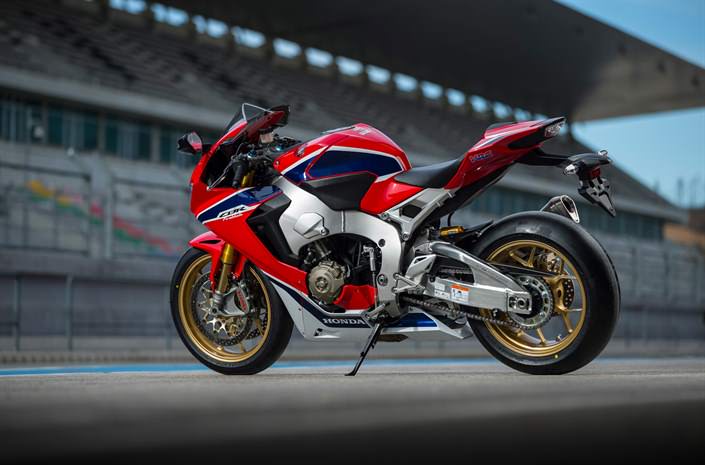
Mr M. Sato, Large Project Leader (LPL) 17YM CBR1000RR Fireblade SP
"All 1000cc sportsbikes are extraordinary examples of high performance engineering. But for us, for our new Fireblade we want extraordinary to be the pleasure of handling and controlling such a machine. Its true purpose – wherever it's ridden – is to enjoy something that is not normally experienced in everyday life, something that cannot be surpassed.
The very first CBR900RR remains a milestone in our history, and an inspiration we have drawn on to radically reduce weight and increase power. And, to go to Next Stage Total Control, we have added an electronic control system that is there to support the rider, totally.
What then can our new Fireblade promise our customers? That is simple – the pure joy of riding."
CBR1000RR Fireblade SP – Next Stage Total Control
2. 2017 CBR1000RR SP Model Overview
Three factors are key to the essence of the new Fireblade SP; less weight, more power and electronics to help the rider wherever and however they're riding.
The new electronic control system provides constant, selectable and fine-tunable rider support. Central to the system is the 5-axis Inertial Measurement Unit (IMU), which measures exactly what the machine is doing, in every plane. It works the Honda Selectable Torque Control (HSTC) that precisely manages rear wheel traction via the FI-ECU and Throttle By Wire (TBW). The new ABS (also managed by the IMU) offers Rear Lift Control (RLC) and the ability for hard, safe trail braking into corners. Any difference measured between the front and rear wheel speeds engages Wheelie Control, depending on settings.
It also works with the Ohlins Objective Based Tuning Interface to adjust both the compression and rebound damping force of the semi-active Öhlins Electronic Control (S-EC) front fork and rear shock. For the rider this means access to a whole new level of handling ability, with suspension reaction – whether working through pre-sets or manual input – that delivers exactly the right amount of control in every situation. It functions as well on the road as it does the track, and for Honda a new era begins.
At the same time as the S-EC is working the suspension, the Honda Selectable Torque Control (HSTC) is precisely managing rear wheel traction through the IMU, FI-ECU and Throttle By Wire (TBW). It also delivers a Wheelie Control function.
Three standard display modes – Street, Circuit and Mechanic – provide all the information required for the rider relevant to the type of riding. The information displayed can be fine-tuned and adjusted while riding by using the left hand switch gear and TFT liquid crystal display, just as on the RC213V-S, Honda's road going version of its RC213V MotoGP machine.
While the electronic control is very much a new departure for the Fireblade, the combination of the other two factors draws faithfully on the philosophy of the original 1992 machine: the optimal balance of power and weight. The engine revs harder and higher, with a much higher compression ratio and revised cam timing, and uses the TBW (a first for an inline four-cylinder Honda) and Acceleration Position Sensor (APS) which have been inspired by the technology developed for the RC213V-S
Bottom end torque and power are improved, with a significant increase in top-end power – up 11 horsepower (8kW) to 189 horsepower (141kW) @ 13,000rpm and 3 modes of engine output character can be chosen from. A Quickshifter is fitted as standard, as is Downshift Assist (with autoblipper) and new assist slipper clutch
Thanks to the use of magnesium and careful assessment and lightening of individual parts the engine also carries 4.4 lbs (2kg) less. The new titanium exhaust muffler saves further weight and aids mass centralization, as does the titanium petrol tank. Overall the CBR1000RR SP is 33 lbs (15kg) lighter than the outgoing model, with a wet weight of 429 lbs (195kg).
The twin-spar aluminum frame's rigidity balance has been finely adjusted, and the swingarm is stiffer to match. A new rear subframe is lighter as are the redesigned wheels, while Brembo monobloc four-piston front brake calipers use high-performance track-ready brake pads.
The CBR1000RR SP 's bodywork outlines an aggressive, functional minimalism, and the machine is slimmer and much more compact with a single seat unit fitted as standard. All lighting is LED and the stunning Tri-color paintwork – on a red base – harks back to Honda racing history.
3. 2017 CBR1000RR SP Key Features
3.1 Chassis/Electronics
- • Inertial Measurement Unit (IMU)
- • Öhlins Electronic Control (S-EC) suspension
- • Honda Selectable Torque Control (HSTC)
- • New ABS
- • Riding Mode Select System (RMSS)
The Fireblade SP is the first Honda motorcycle to be equipped with Öhlins S-EC suspension front and rear: a 43mm NIX30 fork and TTX36 shock.
The Suspension Control Unit (SCU) receives roll rate, yaw rate and lean angle information from a 40g 5-axis (3-axis acceleration and 2-axis angular velocity) Bosch MM5.10 IMU gyro located close to the machine's center of gravity. It also gathers wheel speed, engine rpm, brake input and throttle angle from the FI-ECU and, depending on the suspension mode selected by the rider delivers optimal compression and damping force (adjusted via each step motor) during normal riding, plus hard acceleration, braking and cornering.
There are three Active modes and three Manual modes for the rider to choose from. When set in Active, damping force is controlled and optimized to suit the riding conditions: A1 ('Fast'), A2 ('Enjoy') and A3 ('Safety'). Within the Active Modes the rider can make finer adjustments. The Manual M1, M2 and M3 Modes allow any required adjustments to be made.
Within the electronic control system are a multitude of active features that many riders will find useful. The new ABS allows extremely hard braking while maintaining rear wheel contact with the ground, stopping the tendency for the rear of the machine to elevate or 'back in' around the front. It uses the 2-axis acceleration information from the IMU and calculates the acceleration of the machine's center of gravity in the lift direction and acceleration perpendicular to that, using the front wheel as a grounding point.
ABS delivers smooth, effective braking into a corner. With information from the IMU, plus front and rear wheel speed sensors, the ABS Modulator controls braking force according to lean angle, even when panic braking. But it also allows for hard trail braking by using two parameters (deceleration derived from wheel speed and front/rear slip rates) plus lean angle to vary the threshold for ABS decompression. ABS delivers an extra sense of security when braking hard on the road, and offers a performance edge in certain conditions on the racetrack.
In isolation all the functions of the EBC – plus the HSTC's wheelie control – perform specific, individual tasks. When tied together, however and working seamlessly as one they provide technological rider support that elevates the super sports experience, without turning the rider into the passenger. Next Stage Total Control, indeed.
Like the RC213V-S, the Fireblade SP uses a full-color TFT liquid crystal dash that clearly communicates information to the rider. It automatically adjust to ambient light, with a backlight of up to 1000 cd/m2 luminescence and features 3 modes; Street, Circuitand Mechanic, each displaying information most relevant for usage.
Street displays riding modes (1-3 and USER 1-2) plus the settings for each parameter P (Power), T (HSTC), EB (Selectable Engine Brake) and S (Suspension). Circuit adds in addition to Street mode the lap time, number of laps and difference from the best lap.Mechanic displays the digital tacho, gear position, grip angle, coolant temperature and battery voltage.
Riding mode 1 (FAST) gives full power, with linear throttle response, low HSTC and EB intervention and high damping force. Mode 2 (FUN) controls output through first to third gear, with fairly moderate power increase, medium HSTC, strong EB and medium damping force. Mode 3 (SAFE) controls output through first to fourth gear, with moderate power increase, high HSTC, strong EB and low damping force.
In the 2 USER modes all parameters can be combined and adjusted freely; riding modes, HSTC and suspension settings can be changed while riding from the up/down switch on the left switchgear.
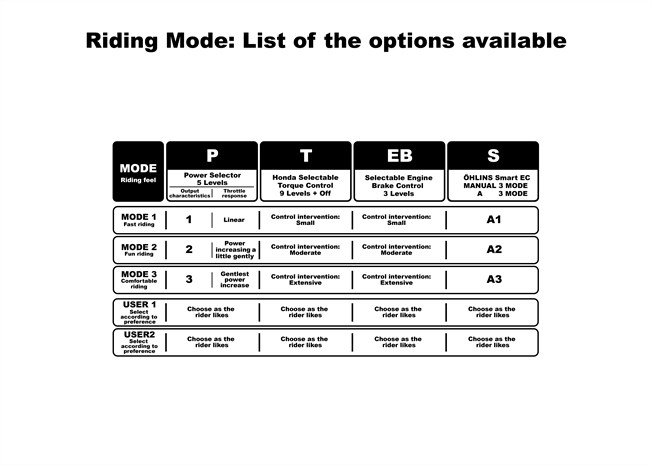
The Shift-Up indicator is a horizontal line of 5 white LEDs located at the top; when engine speeds exceed user presets they go from solid to flashing. Displays include speedometer, tachometer, gear position, quickshifter, coolant temperature, riding distance and twin trip meters.
The onboard computer calculates instantaneous and average fuel economy, trip fuel consumption, average speed and time after last ignition plus remaining fuel after RES light and distance to empty (when selected). This information is shown on the bottom right of the screen. In the upper display, middle right the rider can choose to see the Shift-Up indicator setting speed, grip angle, battery voltage, calendar, or user-defined text.
Switching between modes is controlled by a mode switch on the right of the left hand switchgear. Just above it is an up/down switch that manages and changes the information displayed within the mode.
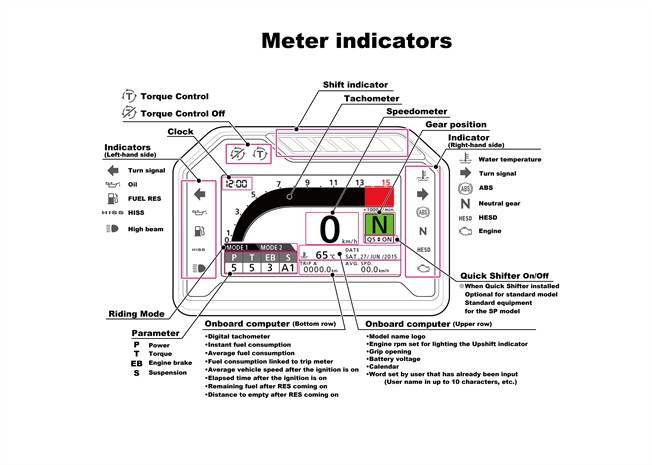
3.2 Chassis
- • 429lb (195kg) wet weight
- • Adjusted rigidity balance for the frame
- • Stiffer swingarm
- • Lighter subframe
- • Titanium fuel tank
- • Brembo four-piston radial mount monobloc brake calipers
- • Redesigned wheels
- • Minimal and aggressively styled bodywork
As a machine now a full 15kg lighter – with a wet weight of 195kg – and with 8kW power boost, the Fireblade's physical handling has also been transformed. Rake and trail remain 23.3°/96mm but the hollow die-cast twin-spar aluminum frame's rigidity balance has been significantly adjusted to give even sweeter handling with outstanding steering response, feel and stability.
Thinned frame walls save 300g. While transverse rigidity is unchanged, the frame is 10% more flexible in the torsional plane, which works to deliver a faster-reacting chassis. Yaw moment of inertia has been reduced by 15%; roll moment of inertia by10%. The Honda Electronic Steering Damper (HESD) unobtrusively maintains stability. To complement the frame changes the aluminum Unit Pro-Link swingarm's hybrid structure has had the thickness of each section adjusted, saving approx. 100g while maintaining transverse rigidity and increasing torsional rigidity.
The die-cast aluminum subframe too has been redesigned and its thinner construction is at the same time highly rigid and 800g lighter – contributing to the concentration of mass and thus neutral handling feel with improved agility. Wheelbase is 1404mm; seat height is 820mm.
Positioned high the weight of the fuel tank (and fuel) plays a significant part in a motorcycle's handling. In another first for mass production Honda has developed a compact 16L titanium fuel tank for the Fireblade SP. Manufactured by an ultra-deep drawing process, it's 1.3kg lighter than an equivalent steel design and contributes to the concentration of mass and reduction in the moment of inertia.
Brembo four-piston monobloc radial mount brake calipers use newly developed high-mu (coefficient of friction) brake pads – these have a greater performance parameter at higher temperatures than standard pads, and suit aggressive ridng. The aluminum wheels are a new five Y-shape design, saving approx. 100g. Tire sizes are 120/70 R17 front and 190/50 R17 rear.
Minimal and dynamic are two words used to best describe the Fireblade SP 's new styling. The design team wanted to create tightly compact proportions and the upper and middle fairing surfaces have been reduced in size as far as possible. Forward tilting character lines inject an aggressive attitude, with a focus on mechanical functionality, detail and quality of finish.
24mm in width has been squeezed from the upper fairing. Airflow control from the flow surfaces of the fairing, to the surface angle of the headlights and the contouring of their side slits supports stability at speed. In a racing crouch the rider is tucked well out of the airstream. In normal riding situations air pressure is evenly distributed on the rider's shoulders, back and sides.
18mm has been saved across the middle fairing and its 'knuckles' double as RAD intake structures that pass discharged air around the outside, and underneath, the rider's legs. The knee grip area is 15mm per side slimmer, with the interface between tank cover and the single seat unit athletically accentuated.
All lighting is crisp LED, with the twin front headlights offering high/low beam on both sides. Crowned with a sharply angled new logo, the Fireblade SP will be available in a Tri-Color paint option that uses red as its base (rather than white) and pays homage to Honda's racing tradition and history. Wing-motif patterns underpin the machine's exclusivity.
A 1kg Lithium-Ion battery saves weight (a lead-acid unit of similar output would weigh 2kg) and provides reliable and consistent electrical charge.
3.3 2017 CBR1000RR SP Engine/Electronics
- • Throttle By Wire (TBW)
- • Acceleration Position Sensor (APS)
- • Power Selector
- • Inertial Measurement Unit (IMU)
- • 9 level Honda Selectable Torque Control (HSTC)
- • Wheelie Control
- • Selectable Engine Brake (SEB)
- • Quickshifter
- • Downshift Assist
- • Riding Mode Select System (RMSS)
The 17YM Fireblade is the first inline four-cylinder engine from Honda to use Throttle by Wire (TBW) control. Derived and developed from the system used by the RC213V-S, its job is to put precise throttle control – and a very natural feel – in the rider's right hand.
Heart of the system is a newly developed throttle grip Acceleration Position Sensor (APS) integrated into the right handlebar switchgear, which itself neatly mounts the engine start/stop switch – nothing more. APS converts movement of the grip into an electrical signal sent to the ECU, that then transmits it as an actuator signal to the TBW motor, achieving ideal throttle control relative to grip angle.
The return spring and other mechanisms inside the APS reproduce the initial play and natural feel of a cable, with throttle load set specifically for the Fireblade SP. Working in conjunction with the APS throttle bore is increased 2mm to 48mm (without increasing exterior width) and careful shaping of the intake funnels adds to the linear throttle response.
The Power Selector can be accessed through the Riding Mode Select System (RMSS). It offers 5 levels of output character: Level 1 give peak output in all six gears; Level 2 output is controlled in each gear to achieve smooth throttle feel under acceleration or deceleration; Level 5 has the strongest output control for most moderate throttle response. All levels have the same throttle response on initial opening.
Riding Mode (1) uses Level 1 as its preset, drawing out the full performance of the engine. Mode (2) uses Level 2, and is suitable for twisty roads, while Mode (3) goes to Level 5 for maximum security. Individual rider preferences can also be input manually through the USER 1 and 2 interface.
The Fireblade employs an enhanced version of the Honda Selectable Torque Control (HSTC) used on the RC213V-S. It controls engine torque via two sensing methods – the first uses wheel speed sensors to measure and compare front and rear wheel speeds. When the FI-ECU detects rear wheel acceleration (and front wheel deceleration) it reduces the TBW throttle position, and thus output, keeping the front wheel on the ground. Maximum application of the throttle is thus possible without fear of wheelies, with the support of Wheelie Control.
The second sensing function detects machine roll angle. The IMU located under the seat detects rotational speed in the chassis' roll and yaw directions, and acceleration in the longitudinal, lateral and vertical directions. It then calculates roll angle to control engine torque, maintaining rear wheel traction at the required level. The body roll calculation logic used by the ECU uses the same attitude detection technologies developed for Honda's ASIMO humanoid robot, enabling the most precise calculation possible.
Nine intervention levels (plus off) are offered by HSTC to suit rider preferences, and the Riding Modes USER 1 and 2 enable individual changes to be made while moving.
There is also a Selectable Engine Brake (SEB) system to change engine-braking character to match rider preference and a range of conditions. Level 1 offers the highest braking force, Level 3 the lowest. The preset Modes 1, 2 and 3 use recommended settings, but through USER 1 and 2 can be set individually.
A Quickshifter is fitted as standard for clutchless upshifts and works through fuel injection cut and ignition retard. It has 3 settings plus off. Downshift Assist allows clutchless downshifts, and also works via fuel injection cut and ignition retard with TBW autoblipping. It too has 3 settings plus off.
3.4 2017 CBR1000RR SP Engine
- • 11 Horsepower (8kW) power increase
- 2017 CBR1000RR SP Horsepower – 189 HP @ 13,000 RPM
- 2017 CBR1000RR SP Torque – 85.6 ft/lb @ 11,000 RPM
- • Revised valve lift and cam timing
- • Magnesium covers and detail redesign saves 2kg
- • 4-2-1 exhaust with titanium muffler
- • Redesigned downshift assist
- • New assist slipper clutch
Honda's engineers exhaustively re-examined the Fireblade's 999.8cc inline four-cylinder engine to make it as light and powerful as possible. The result of the work is an extra 8kW, the loss of 2kg and raised rev ceiling of 13,000rpm.
Peak power on the 2017 CBR1000RR SP comes in at 189 horsepower (141kW) @ 13,000rpm, with peak torque coming in at 85.6 ft/lb (116Nm) delivered @ 11,000 10,500rpm. Bore and stroke remain 76 x 55.1mm but compression ratio is up from 12.3:1 to 13:1. This is an engine in a very high state of tune and the crankshaft, valve train and transmission all use higher specification materials than the previous design.
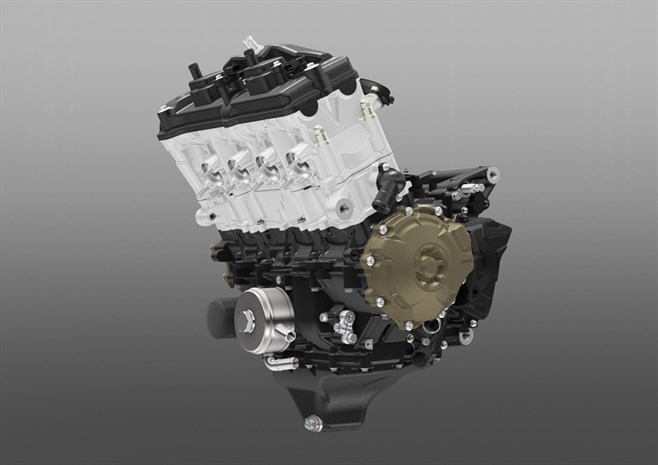
The pistons feature an optimized wall thickness and a new crown design to raise the compression; the surface finishing of the piston-ring grooves has also been modified to improve sealing performance and efficiency. Valve lift and cam timing has been revised to match the higher rpm and greater engine performance.
Power up is just one part of the Fireblade SP 's story – reduced weight is another. So every part of the engine was scrutinised to see if it could be made lighter. All the engine covers are redesigned (clutch cover is aluminum; the ignition cover magnesium) and the length of the bolts, water hose and water hose bands have been reduced.
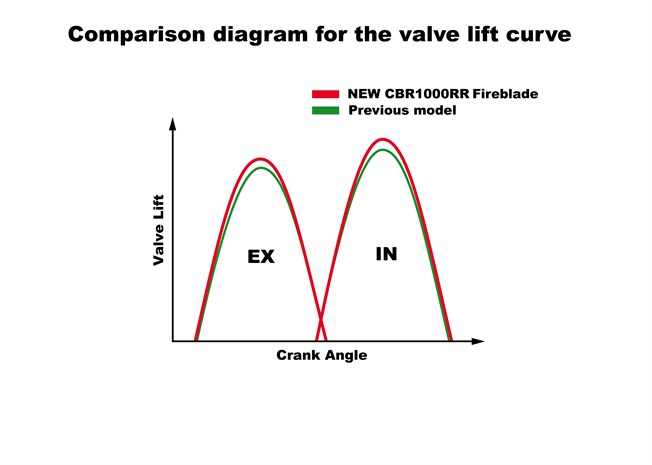
With a revised, rounded shape the radiator is 30mm narrower in overall width and 100g lighter (including a 30cc reduction in water capacity). Using a new high-density core it achieves identical heat dissipation and contributes to the slimmer frontal area of the fairing cowls.
The assist slipper clutch is completely revised with a single die-cast pressure plate and clutch center, and offers reduced load at the lever. For downshifts the slipper functionality remains the same as before but aluminum cam parts (instead of steel) save weight. The gap between the accelerating and decelerating cams has also been optimized, again improving lever feel when changing gear. All of the transmission gears have been pared down to save weight.
The titanium irregular cross-section muffler is 2.8kg lighter and minimizes the center of gravity change; it also creates an unmistakable sound tone from the exhaust on an open throttle. The exhaust supplier to the Repsol Honda MotoGP team was asked to develop the prototype and produced an exquisite design with the 4-2-1 double-skinned downpipes incorporating the exhaust valve within the first main pipe.
4. 2017 Honda CBR1000RR SP / SP2 Quick Overview of Features:
- Full LED Lighting Package
Headlights, tail lights, turn signals—the CBR1000RR SP's have a full street-legal lighting package, and it's all done with lightweight, efficient, cool LEDs. - New Öhlins Smart EC Suspension
The CBR1000RR SP and SP2 feature a new Öhlins Smart EC suspension system. It's fully adjustable, semi-active, truly premium and track-ready — a huge upgrade from what you'd normally find on a streetbike. - New Gyro-Assisted ABS
Every new CBR1000RR SP and SP2 comes standard with anti-lock brakes. But these brakes go one better, including rear-wheel lift control (think hard stopping here), along with a special cornering program that takes lean angle into account. - Brembo Monobloc Front Calipers
The CBR1000RR SP's race-proven, radial-mount Brembo monobloc calipers are light, but they provide exceptional stiffness and excellent braking performance. - Improved Radiator Design
Almost an inch narrower and 100 grams lighter than last year's model, the new radiator tucks in tighter and cools just as efficiently. - Honda Electronic Steering Damper (HESD)
Most steering dampers only sense handlebar-deflection speed. The Honda Electronic Steering Damper (HESD) is way more sophisticated. It also detects vehicle speed, and adjusts damping proportionally. That helps maintain low-speed maneuverability while providing excellent, predictable high-speed handling. - New Thin Film Transfer Display
TFT means an instrument display that's lighter and easier to read than previous LCD designs. It's a first for Honda, and it's making its premier on the new 2017 CBR1000RR's. - Dual-Stage Fuel Injection
The CBR1000RRs feature two sets of injectors per cylinder for both low- and high-rpm performance, instantaneous high-rpm response and great low-rpm metering and clean running. Refined EFI settings make the engine even more manageable, with smoother throttle response specifically at smaller throttle openings. - Improved Twin-Spar Aluminum Chassis
By thinning the sidewalls in the frame's twin spars, we've fine-tuned the chassis responsiveness, especially at aggressive angles. At the same time, we made the swingarm ten percent more torsionally rigid. - Assisted Slipper Clutch
Superbikes can deliver a great deal of back-torque through the driveline, upsetting handling—not the CBR1000RR models. Its Honda-designed assisted slipper clutch is the same type used on our MotoGP bikes. The design does away with the need for heavy clutch springs, ensuring full power transmission with smooth shifting and a light clutch pull at the lever. - Centrally Located Fuel Tank
The CBR1000RR SP and SP2 feature a radical, new thin-wall titanium fuel tank. Filled to capacity, the tank is almost four and a half pounds lighter, but still offers plenty of operational range. - Slimmer Ergonomics
The new CBR1000RRs are much slimmer in the tank/seat junction area, and also in the upper cowl (more than 12mm trimmer per side). This improves aerodynamics, and the narrow tank makes it easier to tuck in. - Lightweight Sub-Frame
Almost a full pound lighter than our previous models, the new CBR1000RR sub-frame further refines our mass centralization efforts. Light is always right, and the new CBR1000RRs offer Superbike performance in a package that weighs no more than a typical 600 Supersport. - Lithium Ion Battery
Light and compact, the new CBR1000RR SP and SP2 come standard with a high-tech lithium-ion battery. - Titanium Muffler
MotoGP bikes use titanium for their mufflers, and so do the new CBR1000RR SP and SP2. It's a significant weight savings. - Premium Wheels
You'll notice that the new CBR1000RR SP features new five-spoke wheels. They're light and strong—more than a pound lighter than the previous six-spoke wheels. The SP2 offers an even more impressive upgrade: lightweight, premium Marchesini wheels.
2017 CBR1000RR SP2 Photo Gallery / Pictures
5. 2017 CBR1000RR SP Technical Specifications
| ENGINE | |
| Type | Liquid-cooled 4-stroke 16-valve DOHC Inline-4 |
| Engine Displacement (cm³) | 999cc |
| No. of Valves per Cylinder | 4 |
| Bore ´ Stroke (mm) | 76 x 55 |
| Compression Ratio | 13:01 |
| Max. Power Output | 189 HP / 141kW @ 13,000rpm |
| Max. Torque | 85.6 FT/LB (116Nm) @ 11,000rpm |
| Oil Capacity | 3.4L |
| FUEL SYSTEM | |
| Carburation | PGM-DSFI |
| Fuel Tank Capacity | 16L |
| Fuel Consumption | TBC |
| ELECTRICAL SYSTEM | |
| Starter | Electric |
| Battery Capacity | 12V-4.5AH(Li-ion) |
| ACG Output | 0.42kw |
| DRIVETRAIN | |
| Clutch Type | Wet, multiplate clutch |
| Transmission Type | 6-speed |
| Final Drive | Chain |
| FRAME | |
| Type | Diamond; aluminum composite twin spar |
| CHASSIS | |
| Dimensions (LxWxH) | 2,065mm x 715mm x 1125mm |
| Wheelbase | 1404mm |
| Caster Angle | 23.3° |
| Trail | 96mm |
| Seat Height | 32.2 in (820mm) |
| Ground Clearance | 129mm |
| Curb Weight | 429 lbs (195 kg) |
| Turning radius | – |
| SUSPENSION | |
| Type Front | Telescopic inverted fork with an inner tube diameter of 43mm, and a NIX30 Smart-EC (OHLINS) Front Fork with preload, compression and rebound adjustments, 120mm stroke |
| Type Rear | Unit Pro-Link with gas-charged TTX36 Smart-EC (Öhlins) damper featuring preload and compression and rebound damping adjustment, 60mm stroke |
| WHEELS | |
| Rim Size Front | 17 inch |
| Rim Size Rear | 17 inch |
| tires Front | 120/70ZR17 58W |
| tires Rear | 190/50ZR17 73W |
| BRAKES | |
| ABS System Type | 2 Channel |
| INSTRUMENTS & ELECTRICS | |
| Instruments | TFT-LCD |
| Security System | HISS |
| Headlight | LED |
| Taillight | LED |
All specifications are provisional and subject to change without notice.
Newsletter
Signup for Honda PowerSports News / Model Updates!
Thank you!
You have successfully joined our subscriber list.
Source: https://www.hondaprokevin.com/2017-cbr1000rr-sp-fireblade-review-changes-specs-sport-bike-cbr-motorcycle-news
 Reviewed by Admin
on
Desember 01, 2021
Rating:
Reviewed by Admin
on
Desember 01, 2021
Rating:
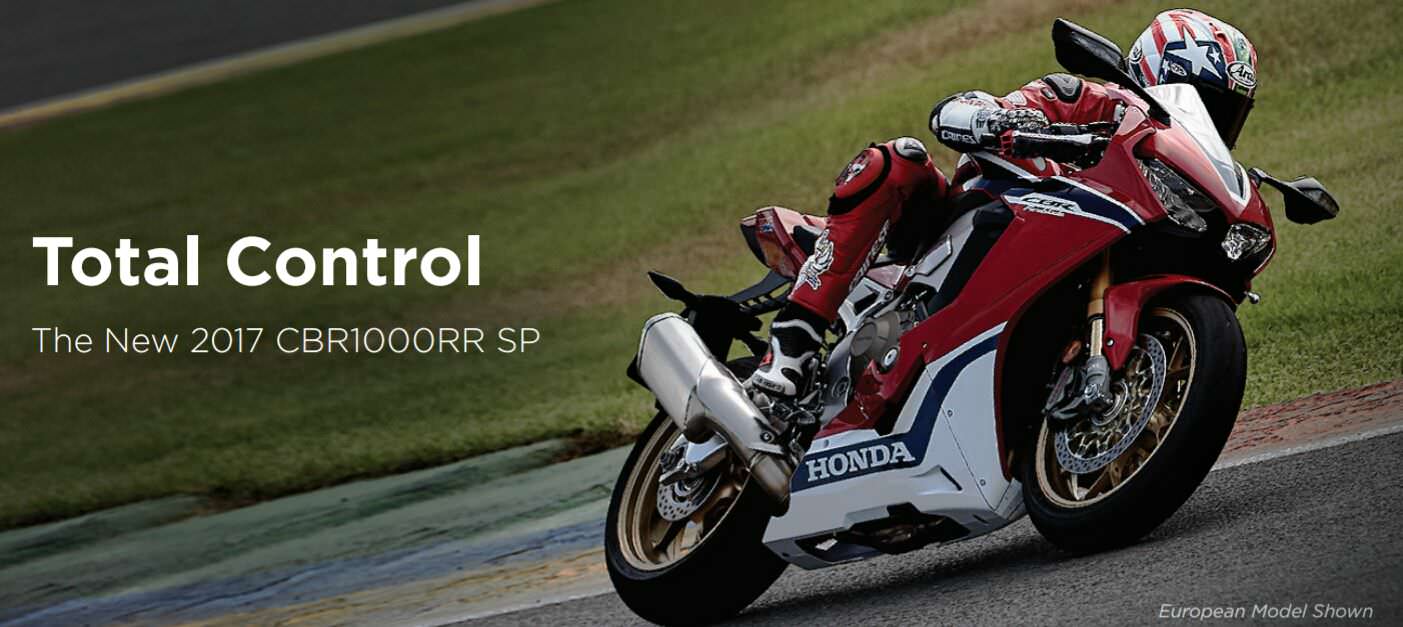

Tidak ada komentar: